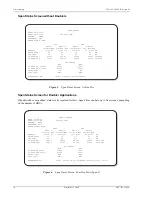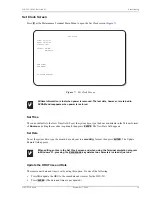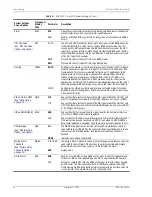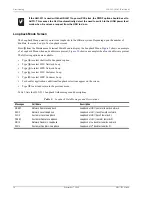
150-231-181-01, Revision 01
Provisioning
HLU-231 List 8A
September 7, 1999
25
Margin Alarm Threshold Option
To set the Margin Alarm Threshold:
1
Select
from the System Settings Main Menu screen.
2
Enter the desired minimum acceptable alarm threshold from the 0 to 15 dB range. This causes a system alarm
to occur if either the margin on HDSL Loop 1 (MAL1) or Loop 2 (MAL2) drops below the selected threshold
value.
HAIS Option
The HAIS option provides two selections for the T1 transmit outputs at both the HLU-231 and HRU for HDSL
loss of sync conditions.
•
1LP
causes the AIS (LOS if ALMP is set to LOS) pattern to be transmitted at both T1 outputs when either
of the two HDSL loops experience an out-of-sync (LOSW) condition or when a margin alarm occurs. 1LP
causes the 12 channels on the surviving loop to be lost as they are replaced by the AIS/LOS pattern. However,
it does notify downstream and upstream equipment of the loss of one HDSL loop or a loop with low margin.
This is the preferred setting for initiating an AIS/LOS state with just one conductor open in either of the
HDSL pairs. Short loops, below approximately 16 dB of loss at 200 kHz, can remain in sync with one
conductor open. Since the loop is still in sync, no LOSW condition occurs. However, the margin on a
one-conductor loop drops from 5 to 10 dB. Therefore, if the Margin alarm is set to 5 dB below the normal
margin at turn-up, when one conductor does open, a system alarm occurs and causes the AIS/LOS condition.
This alerts the maintenance personnel of the problem.
•
2LP requires both HDSL loops to be out of sync (LOSW) before the HAIS signal is transmitted. 2LP
preserves the integrity of the 12 surviving channels when just one loop is lost.
HDSL Line Voltage Options
The PWRF option has four settings for HDSL line power feed: DIS, LOW, AUTO, and HIGH.
•
DIS
disables any voltage from being applied to the HDSL cable pairs. It is useful to prevent craft personnel
from being exposed to the HDSL line voltage when they are working on the cable pairs.
•
LOW
limits the HDSL simplex voltage to -140 Vdc maximum. This is the standard voltage used in all
non-doubler applications and has no effects in these applications. It can be chosen to limit line-powered,
single-doubler circuits or locally-powered, two-doubler circuits up to -140 Vdc, if the appropriate HiGain
products (HDU-409, HDU-404 or HDU-407 and HRU-402 or HRU-411) are used along with the HLU-231
List 8A. These HiGain units are the only ones that have sufficiently low power consumption to allow their
doubler circuits to be line-powered from -140 Vdc. The HRU-411 must have the CPE power option disabled
if it is used in a -140 Vdc doubler circuit.
•
AUTO is the conventional mode in which the HLU automatically maintains the HDSL line voltage at
-140 Vdc maximum for non-doubler applications and
112 Vdc for doubler applications.
•
HIGH forces the HDSL line voltage to its high ±112 Vdc level for applications. It is needed to allow the HLU
to power circuits that are providing power to remote Personal Communication Systems (PCS) sites.
Since the margin can never drop below zero, choosing
(zero) for the margin threshold turns
the margin alarm off.
P
0






























